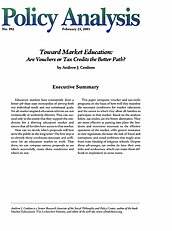Education markets have consistently done a better job than state monopolies of serving both our individual needs and our communal goals. Yet all market-inspired education reforms are not intrinsically or uniformly effective. They can succeed only to the extent that they support the conditions for a thriving education market and ensure that all families have access to that market.
How can we decide which proposals will best serve the public in the long term? The first step is to identify those conditions necessary and sufficient for an education market to work. That done, we can compare various proposals to see which successfully create those conditions and which do not.
This paper compares voucher and tax-credit programs on the basis of how well they manifest the necessary conditions for market education and the extent to which they allow all families to participate in that market. Based on the analysis below, tax credits are the better alternative. They are more effective at putting into place the freedoms and incentives necessary to the effective operation of the market, offer greater resistance to new regulation, decrease the risk of fraud and corruption, and avoid problems that might arise from state funding of religious schools. Despite those advantages, tax credits do have their own risks and weaknesses, which can make them difficult to implement in some states.

This work is licensed under a Creative Commons Attribution-NonCommercial-ShareAlike 4.0 International License.

